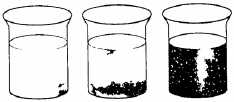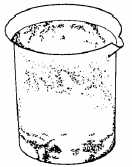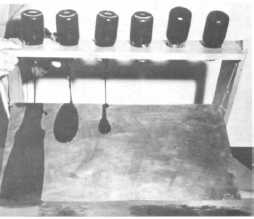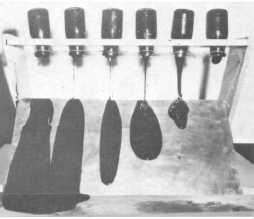FROM
LEFT
TO
RIGHT:
KEROSENE,
KEROSENE PLUS TAR, KEROSENE PLUS
ASPHALT CEMENT OR ASPHALT CUTBACK.
BEADS FORMED BY ASPHALT EMULSION IN
KEROSENE.
Figure 8-22.—Solubility test for asphalt, tar,
and emulsion.
Pour Test
When you perform the volubility test
and the bituminous material dissolves, an
asphalt product–asphalt cement or asphalt
cutback–is present. At room temperature
(77 F) asphalt cements are solids, and asphalt
cutbacks are fluids. With these facts in mind,
you may run a second test, a pour test, to
determine whether a sample is an asphalt
cement or an asphalt cutback.
In the pour test, an attempt is made to pour
the material from a small container. Asphalt
cements are solids and will not pour. Asphalt
cutbacks are fluids at 77 F and will pour (fig. 8-
23).
A pour test is also used to identify the 12
viscosity grades of tar. Viscosity grades of road tar
are comparable to the viscosity grades of asphalt
cutbacks and asphalt cement (table 8-5). RT-1, the
most fluid, is similar in viscosity to the grade 30 of
the rapid-curing, medium-curing, and slow-curing
types of asphalt cutbacks. RT-8 is similar to grade
800 asphalt cutback. RT-12 has the approximate
consistency
of
asphalt
cement
of
200-300
penetration.
Road tar grades 4, 5, and 7, which are identical
in appearance to road tar cutback grades 5 and 6 may be
distinguished through a smear test. Like asphalt
ASPHALT CEMENT ON LEFT.
ASPHALT CUTBACK ON RIGHT.
LEFT TO RIGHT: ASPHALT CUTBACKS GRADE
30, 70, 250, 800, AND 3,000 THREE SECONDS
AFTER TIPPING FULL JARS.
THIRTEEN SECONDS AFTER
TIPPING FULL JARS.
143.179
Figure 8-23.—Pour test for asphalt
and cutbacks.
cutbacks, road tar cutbacks cure rapidly since they
are thinned with highly volatile materials that
evaporate quickly and leave a sticky substance within
a 10-minute period. On the other hand, because the
fluid coal oil in road tars evaporates slowly, road tars
will remain at the same consistency at the end of an
identical period.
8-25










